Survey Analysis
Contents
Survey Analysis¶
We often want to survey people on their views or reactions to possible events (design or promotion, for example). There are many survey tools that are good in designing the survey, presenting it on various forms, such as web or mobile, distributing it and collecting the responses. However, when it comes to analyzing the responses, you are left with fewer options, and most of them are out-dated (SPSS, for example).
In this notebook, we will explore how to analyze survey’s responses, including statistical tests for reliability and research hypothesis.
We will start with loading the CSV files that we exported from the survey system (Qualtrics, in this example).
import warnings
warnings.filterwarnings('ignore')
import pandas as pd
survey_df = pd.read_csv('../data/survey_results.csv')
Survery Overview¶
We can explore the number of questions and answers with info
survey_df.info()
<class 'pandas.core.frame.DataFrame'>
RangeIndex: 97 entries, 0 to 96
Data columns (total 65 columns):
# Column Non-Null Count Dtype
--- ------ -------------- -----
0 StartDate 97 non-null object
1 EndDate 97 non-null object
2 Status 97 non-null object
3 IPAddress 97 non-null object
4 Progress 97 non-null object
5 Duration (in seconds) 97 non-null object
6 Finished 97 non-null object
7 RecordedDate 97 non-null object
8 ResponseId 97 non-null object
9 RecipientLastName 1 non-null object
10 RecipientFirstName 1 non-null object
11 RecipientEmail 1 non-null object
12 ExternalReference 1 non-null object
13 LocationLatitude 97 non-null object
14 LocationLongitude 97 non-null object
15 DistributionChannel 97 non-null object
16 UserLanguage 97 non-null object
17 Q_RecaptchaScore 95 non-null object
18 E1 97 non-null object
19 A2 97 non-null object
20 C3 97 non-null object
21 N4 97 non-null object
22 I5 97 non-null object
23 E6R 97 non-null object
24 A7R 97 non-null object
25 C8R 97 non-null object
26 N9R 97 non-null object
27 I10R 97 non-null object
28 E11 97 non-null object
29 A12 97 non-null object
30 C13 97 non-null object
31 N14 97 non-null object
32 I15R 97 non-null object
33 E16R 97 non-null object
34 A17R 97 non-null object
35 C18R 97 non-null object
36 N19R 97 non-null object
37 I20R 97 non-null object
38 Q71_First Click 50 non-null object
39 Q71_Last Click 50 non-null object
40 Q71_Page Submit 50 non-null object
41 Q71_Click Count 50 non-null object
42 Q73_First Click 48 non-null object
43 Q73_Last Click 48 non-null object
44 Q73_Page Submit 48 non-null object
45 Q73_Click Count 48 non-null object
46 Expectation1 97 non-null object
47 Expectation2 97 non-null object
48 Trust1 97 non-null object
49 Trust2 97 non-null object
50 Trust5 97 non-null object
51 Trust6 97 non-null object
52 Trust7 97 non-null object
53 Trust8 97 non-null object
54 Trust9 97 non-null object
55 Expectation3 97 non-null object
56 Offering1 97 non-null object
57 Offering2 97 non-null object
58 Offering3 97 non-null object
59 Gender 97 non-null object
60 Age 97 non-null object
61 Education 97 non-null object
62 Region 97 non-null object
63 Q53 97 non-null object
64 Random ID 97 non-null object
dtypes: object(65)
memory usage: 49.4+ KB
Cliping outliers¶
We want to remove outliers to avoid issues from people answering too quick or too slow. Let’s calculate the 0.05 and 0.95 percentiles of the data:
(
survey_df
.loc[1:,['Duration (in seconds)']]
.astype(int)
.quantile([0.05, 0.95])
)
| Duration (in seconds) | |
|---|---|
| 0.05 | 87.25 |
| 0.95 | 1171.00 |
And now we can clip the data to be above 90 and below 1,100
valid_survey_df = (
survey_df
.loc[1:,:]
.assign(duration = lambda x : pd.to_numeric(x['Duration (in seconds)']))
.query("duration > 90 and duration < 1100")
)
valid_survey_df
| StartDate | EndDate | Status | IPAddress | Progress | Duration (in seconds) | Finished | RecordedDate | ResponseId | RecipientLastName | ... | Offering1 | Offering2 | Offering3 | Gender | Age | Education | Region | Q53 | Random ID | duration | |
|---|---|---|---|---|---|---|---|---|---|---|---|---|---|---|---|---|---|---|---|---|---|
| 1 | 2/19/2021 3:28:19 | 2/19/2021 3:30:28 | IP Address | 47.35.194.33 | 100 | 129 | True | 2/19/2021 3:30:29 | R_2WUYft76PXR2zBS | NaN | ... | 3 | 4 | 2 | Female | 40-50 | Bachelor’s degree | North America | IM_6m0pkPqaVoiPxY1 | 58834 | 129 |
| 2 | 2/19/2021 3:28:16 | 2/19/2021 3:30:36 | IP Address | 151.65.216.111 | 100 | 140 | True | 2/19/2021 3:30:37 | R_3eq8jucMfNqn5A4 | NaN | ... | 5 | 5 | 3 | Male | 18-28 | Bachelor’s degree | Europe | IM_6m0pkPqaVoiPxY1 | 21882 | 140 |
| 3 | 2/19/2021 3:29:12 | 2/19/2021 3:31:01 | IP Address | 73.176.57.130 | 100 | 108 | True | 2/19/2021 3:31:01 | R_1jOnl4rE5r7qMcE | NaN | ... | Very likely\n7 | 6 | 6 | Male | 29-39 | Bachelor’s degree | North America | IM_6m0pkPqaVoiPxY1 | 59587 | 108 |
| 4 | 2/19/2021 3:29:18 | 2/19/2021 3:31:07 | IP Address | 86.106.87.89 | 100 | 109 | True | 2/19/2021 3:31:07 | R_BxBBo8wdgckIP7j | NaN | ... | 4 | 5 | Very influential\n7 | Male | 29-39 | Bachelor’s degree | South America | IM_6m0pkPqaVoiPxY1 | 52402 | 109 |
| 5 | 2/19/2021 3:29:06 | 2/19/2021 3:31:28 | IP Address | 27.57.12.252 | 100 | 142 | True | 2/19/2021 3:31:29 | R_2ea55lhudZuzX2J | NaN | ... | 5 | 5 | 4 | Male | 29-39 | Master Degree | Asia | IM_6m0pkPqaVoiPxY1 | 64888 | 142 |
| ... | ... | ... | ... | ... | ... | ... | ... | ... | ... | ... | ... | ... | ... | ... | ... | ... | ... | ... | ... | ... | ... |
| 92 | 2/19/2021 4:01:13 | 2/19/2021 4:15:24 | IP Address | 117.199.129.182 | 100 | 850 | True | 2/19/2021 4:15:24 | R_3HXHwga41cOCWJ3 | NaN | ... | 6 | 5 | Very influential\n7 | Female | 29-39 | Bachelor’s degree | Asia | IM_6m0pkPqaVoiPxY1 | 23065 | 850 |
| 93 | 2/19/2021 4:05:50 | 2/19/2021 4:15:54 | IP Address | 196.18.164.102 | 100 | 604 | True | 2/19/2021 4:15:55 | R_2sTpV27TMoq55Nj | NaN | ... | 5 | 5 | 5 | Female | +62 | Bachelor’s degree | North America | IM_6m0pkPqaVoiPxY1 | 56488 | 604 |
| 94 | 2/19/2021 4:14:37 | 2/19/2021 4:17:39 | IP Address | 70.39.92.10 | 100 | 181 | True | 2/19/2021 4:17:39 | R_10IT3z1yGSWIddU | NaN | ... | Very likely\n7 | Very probable\n7 | Very influential\n7 | Female | 29-39 | Bachelor’s degree | North America | IM_6m0pkPqaVoiPxY1 | 10094 | 181 |
| 95 | 2/19/2021 4:10:47 | 2/19/2021 4:18:35 | IP Address | 182.65.119.175 | 100 | 467 | True | 2/19/2021 4:18:35 | R_2q9815sUara9kKO | NaN | ... | 6 | Very probable\n7 | Very influential\n7 | Female | 29-39 | Master Degree | Asia | IM_6m0pkPqaVoiPxY1 | 88800 | 467 |
| 96 | 2/19/2021 4:20:30 | 2/19/2021 4:22:18 | IP Address | 117.213.34.183 | 100 | 108 | True | 2/19/2021 4:22:19 | R_2VpU6ciTRw7Kdyf | NaN | ... | 5 | Very probable\n7 | 6 | Male | 29-39 | Bachelor’s degree | Asia | IM_6m0pkPqaVoiPxY1 | 68054 | 108 |
83 rows × 66 columns
(
valid_survey_df
['duration']
.plot(
kind='hist',
alpha=0.5,
title='Duration (in seconds) (between 0.05 and 0.95)'
)
);

Map of responders¶
Most of the survey tools are also reporting regarding the location of the responders with their location information. This survey also has this data in LocationLongitude and Locationlatitude columns. We can use the popular GeoPandas package to show them over the world map.
Create from GeoPandas
a geo-location data frame
based on the survey table above
Use the geometry information to draw points based on
\(x\) as location longitude, and
\(y\) as location latitude
%pip install geopandas --quiet
Note: you may need to restart the kernel to use updated packages.
import geopandas
import matplotlib.pyplot as plt
gdf = (
geopandas
.GeoDataFrame(
valid_survey_df,
geometry=geopandas.points_from_xy(
valid_survey_df.LocationLongitude,
valid_survey_df.LocationLatitude)
)
)
Create a map of the world based on the built-in map from GeoPandas
Plot the background map with
while background and
black lines
and the locations of the responders in red
Set the title of the map to “Survey Reponders Locations”
world = (
geopandas
.read_file(
geopandas
.datasets
.get_path('naturalearth_lowres')
)
)
gdf.plot(
ax=(
world
.plot(
color='white',
edgecolor='black',
figsize=(15,10)
)
),
color='red',
).set_title("Survey Reponders Locations");
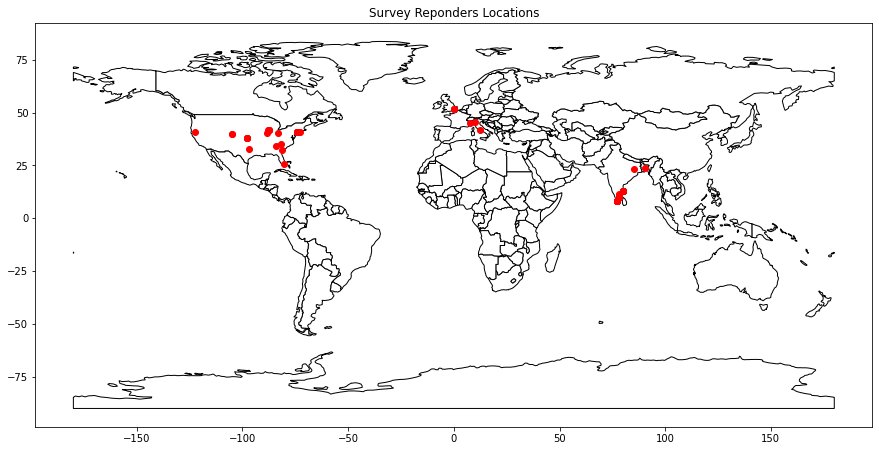
Personality Score¶
The first part of the survey was a personality score that we need to analyze to build the score of each responder. We can find the psychology test format in a previous reserach:
Mini-IPIP test questions¶
Based on: “The Mini-IPIP Scales: Tiny-Yet-Effective Measures of the Big Five Factors of Personality”
Appendix 20-Item Mini-IPIP
Item |
Factor |
Text |
|---|---|---|
1 |
E |
Am the life of the party. |
2 |
A |
Sympathize with others’ feelings |
3 |
C |
Get chores done right away. |
4 |
N |
Have frequent mood swings. |
5 |
I |
Have a vivid imagination. |
6 |
E |
Don’t talk a lot. (R) |
7 |
A |
Am not interested in other people’s problems. (R) |
8 |
C |
Often forget to put things back in their proper place. (R) |
9 |
N |
Am relaxed most of the time. (R) |
10 |
I |
Am not interested in abstract ideas. (R) |
11 |
E |
Talk to a lot of different people at parties. |
12 |
A |
Feel others’ emotions. |
13 |
C |
Like order. |
14 |
N |
Get upset easily. |
15 |
I |
Have difficulty understanding abstract ideas. (R) |
16 |
E |
Keep in the background. (R) |
17 |
A |
Am not really interested in others. (R) |
18 |
C |
Make a mess of things. (R) |
19 |
N |
Seldom feel blue. (R) |
20 |
I |
Do not have a good imagination. (R) |
First, let’s get the questions that are written in the first line (index=0) of the table. We want the 20 questions from index 18 to index 38.
(
survey_df
.iloc[0,18:38]
)
E1 Am the life of the party.
A2 Sympathize with others' feelings.
C3 Get chores done right away.
N4 Have frequent mood swings.
I5 Have a vivid imagination.
E6R Don't talk a lot.
A7R Am not interested in other people's problems.
C8R Often forget to put things back in their prope...
N9R Am relaxed most of the time.
I10R Am not interested in abstract ideas.
E11 Talk to a lot of different people at parties.
A12 Feel others' emotions.
C13 Like order.
N14 Get upset easily.
I15R Have difficulty understanding abstract ideas.
E16R Keep in the background.
A17R Am not really interested in others.
C18R Make a mess of things.
N19R Seldom feel blue.
I20R Do not have a good imagination.
Name: 0, dtype: object
Let’s check how the results look like in the table:
survey_df.E1
0 Am the life of the party.
1 Strongly Disagree\n1
2 Strongly Disagree\n1
3 Somewhat agree\n4
4 Somewhat agree\n4
...
92 Somewhat agree\n4
93 Strongly Disagree\n1
94 Somewhat agree\n4
95 Strongly Disagree\n1
96 Strongly agree\n5
Name: E1, Length: 97, dtype: object
We see that we have five personality traits that we are measuring with these questions: E, A, C, N, I.
Create a variable for each personality trait above
Convert each question to its relevant trait by taking the numertic score at the last character of the question as an Integer, and add it to the relevant trait score. Note that some of the scores are reversed and you need to add the reversed score (6 - score, for a 1-5 score as we have here)
survey_ipip_df = (
valid_survey_df
# Initial values to 0
.assign(E = 0)
.assign(A = 0)
.assign(C = 0)
.assign(N = 0)
.assign(I = 0)
# Update based on survy score
.assign(E = lambda x : x.E + x.E1.str[-1:].astype(int))
.assign(A = lambda x : x.A + x.A2.str[-1:].astype(int))
.assign(C = lambda x : x.C + x.C3.str[-1:].astype(int))
.assign(N = lambda x : x.N + x.N4.str[-1:].astype(int))
.assign(I = lambda x : x.I + x.I5.str[-1:].astype(int))
.assign(E = lambda x : x.E + 6 - x.E6R.str[-1:].astype(int))
.assign(A = lambda x : x.A + 6 - x.A7R.str[-1:].astype(int))
.assign(C = lambda x : x.C + 6 - x.C8R.str[-1:].astype(int))
.assign(N = lambda x : x.N + 6 - x.N9R.str[-1:].astype(int))
.assign(I = lambda x : x.I + 6 - x.I10R.str[-1:].astype(int))
.assign(E = lambda x : x.E + x.E11.str[-1:].astype(int))
.assign(A = lambda x : x.A + x.A12.str[-1:].astype(int))
.assign(C = lambda x : x.C + x.C13.str[-1:].astype(int))
.assign(N = lambda x : x.N + x.N14.str[-1:].astype(int))
.assign(I = lambda x : x.I + 6 - x.I15R.str[-1:].astype(int))
.assign(E = lambda x : x.E + 6 - x.E16R.str[-1:].astype(int))
.assign(A = lambda x : x.A + 6 - x.A17R.str[-1:].astype(int))
.assign(C = lambda x : x.C + 6 - x.C18R.str[-1:].astype(int))
.assign(N = lambda x : x.N + 6 - x.N19R.str[-1:].astype(int))
.assign(I = lambda x : x.I + 6 - x.I20R.str[-1:].astype(int))
# Calculate the average
.assign(E = lambda x : x.E / 4)
.assign(A = lambda x : x.A / 4)
.assign(C = lambda x : x.C / 4)
.assign(N = lambda x : x.N / 4)
.assign(I = lambda x : x.I / 4)
)
Personality Trait Visualization¶
We can show a quick histogram of one or two of the traits
(
survey_ipip_df
.E
.hist()
).set_title("Extraversion");
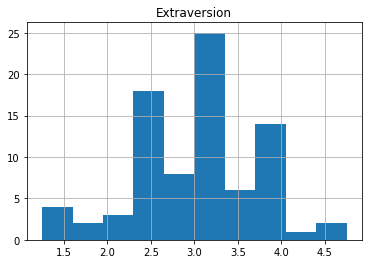
(
survey_ipip_df
.I
.hist()
).set_title("Openness to experience");
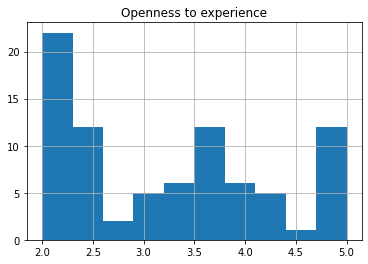
Random Groups¶
Many tests are using split to random groups to check the effect of a treatment on one of the group, while using the other group as a control group (or any other similar test method). In the survey, the group will be visible with answers on some of the questions, while other groups will answer different questions. In this survey, there were two groups that were assigned randomaly question 71 or question 73.
Create a new column in the table called group
create the first condition to have an answer (not null) in Q71 column
create the second condition to have an answer in Q73 column
assign the group value to be ‘Group A’ for the first condition
assign the group value to be ‘Group B’ for the second condition
assign a default value ‘Unknown’ if none of the condition is mapped
import numpy as np
survey_ipip_df['group'] = np.select(
[
survey_ipip_df['Q71_Page Submit'].notnull(),
survey_ipip_df['Q73_Page Submit'].notnull(),
],
[
'Group A',
'Group B'
],
default='Unknown'
)
Research questions¶
The third part is the research questions part, where we want to test the impact of the treatment on the answers to these questions. From the list of columns in the table that we did in the beginning we see that these are starting with ‘Expectation1’, and ends with ‘Offering3’
survey_questions = (
survey_df
.loc[0,'Expectation1':'Offering3']
)
survey_questions
Expectation1 The chatbot's messages met my expectations.
Expectation2 The chatbot's messages corresponded to how I e...
Trust1 The bike chatbot seemed to care about me.
Trust2 The bike chatbot made me feel good.
Trust5 I believe the bike chatbot was honest with me.
Trust6 I believe the bike chatbot didn’t make false c...
Trust7 I believe the bike chatbot is trustworthy.
Trust8 I trust the bike chatbot.
Trust9 The bike chatbot seemed adequate to my needs.
Expectation3 The chatbot's messages were appropriate.
Offering1 What is the likelihood that you would accept t...
Offering2 How probable is it that you would accept the c...
Offering3 How influential do you perceive the chatbot’s ...
Name: 0, dtype: object
Convert all the values of these questions to numeric values based on the last characters ([-1:]) of the answer and set its type to be Interger
numeric_survey_ipip_df = (
survey_ipip_df
.apply(lambda x:
x.str[-1:].astype(int)
if x.name.startswith('Expectation')
else x
)
.apply(lambda x:
x.str[-1:].astype(int)
if x.name.startswith('Trust')
else x
)
.apply(lambda x:
x.str[-1:].astype(int)
if x.name.startswith('Offering')
else x
)
)
Testing Reliability with Cronbach’s \(\alpha\)¶
A common test to check the reliability of the answers is to test them using Cronbach’s alpha test. We expect that all the questions that are related to Trust, for example, will have a high correlation, and therefore a cronbach-alpha score that is higher than 0.7.
First, let’s install a python library with cronbach-alpha function in it.
pip install pingouin --quiet
Note: you may need to restart the kernel to use updated packages.
import pingouin as pg
Now, let’s take the set of questions for each variable (Expectation, Trust, and Offering in this survey) and calculate their score:
pg.cronbach_alpha(data=
numeric_survey_ipip_df
.loc[:,
['Expectation1','Expectation2','Expectation3']
]
)
(0.7635463917525775, array([0.659, 0.84 ]))
pg.cronbach_alpha(data=
numeric_survey_ipip_df
.loc[:,
['Trust1','Trust2','Trust5','Trust6','Trust7','Trust8','Trust9']
]
)
(0.7665523059220511, array([0.681, 0.836]))
pg.cronbach_alpha(data=
numeric_survey_ipip_df
.loc[:,
['Offering1','Offering2','Offering3']
]
)
(0.7863454562366294, array([0.692, 0.855]))
Calculate the research variables¶
Now that we see that the reliability of the question is good enough (>0.7), we can calculate the average score of each of these questions sets. We will use eval function to do it:
summary_numeric_survey_df = (
numeric_survey_ipip_df
.eval("Expectation = (Expectation1 + Expectation2 + Expectation3) / 3")
.eval("Offering = (Offering1 + Offering2 + Offering3) / 3")
.eval("Trust = (Trust1 + Trust2 + Trust5 + Trust6 + Trust7 + Trust8 + Trust9) / 7")
)
(
summary_numeric_survey_df
[['Expectation','Expectation1','Expectation2','Expectation3','group']]
.boxplot(by='group', figsize=(13,8))
);
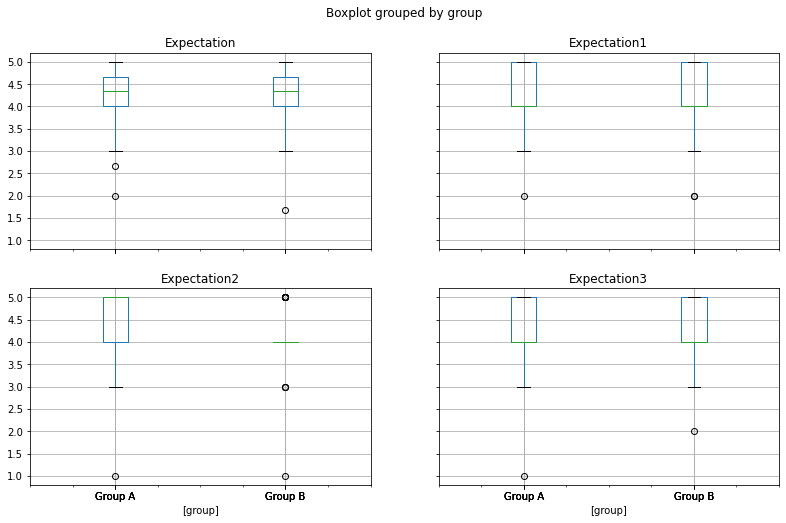
We can plot the correlation of any of the personality traits (first part of the survey), with the score to any of the research questions (third part), within the two different grups (second part)
Create a grid of 3 by 2 to show the graphs of the research question * groups
For each one of the reserach questions and
for each of the groups
filter the table to include only the current group
Plot a regression plot (points, line and confidence area)
\(x\) as E (personality)
\(y\) as the research question
on the chart grid
Set the title of each graph the name of the group
import seaborn as sns
### PLOT BUILD
fig, ax = plt.subplots(3, 2, figsize=(10,8))
for idx, attribute in enumerate(['Expectation','Trust','Offering']):
for i, group in enumerate(['Group A', 'Group B']):
sub_df = (
summary_numeric_survey_df
.query('group == @group')
)
(
sns
.regplot(
x=sub_df.E,
y=sub_df[attribute],
ax=ax[idx,i]
)
)
ax[idx,i].set_title(group, loc='left')
fig.tight_layout()
plt.show()
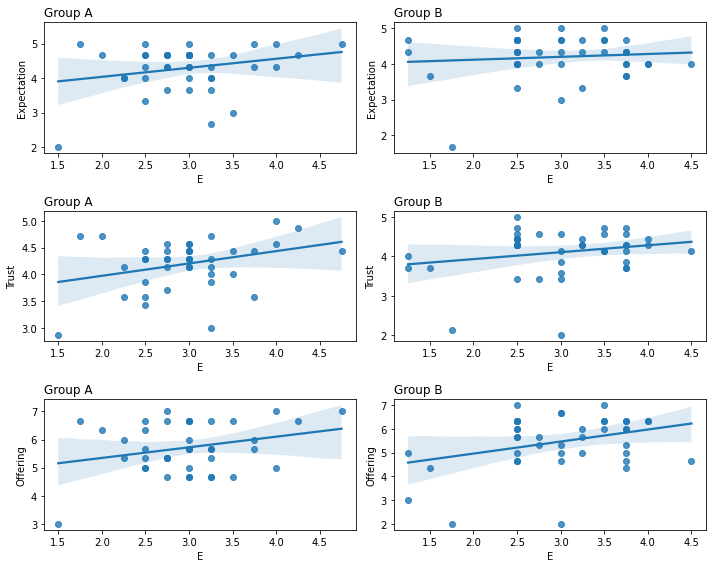
Anova¶
The last part of the analysis is the null hypothsis check that the groups are making a different impact on the relationship between the personality trait and the reserach questions.
import statsmodels.api as sm
from statsmodels.formula.api import ols
model = ols(
f'Trust ~ C(group) * E',
data=(
summary_numeric_survey_df
.loc[:,['E','Trust','group']]
)
).fit()
fig = sm.graphics.plot_regress_exog(model, "E")
fig.tight_layout(pad=1.0)
eval_env: 1
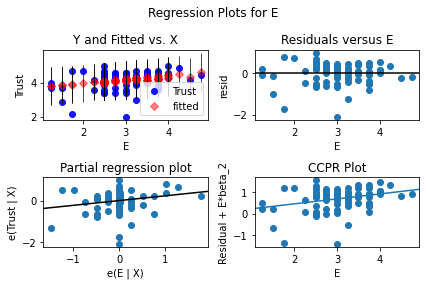
for attribute in ['Expectation','Trust','Offering']:
print(attribute)
model = ols(
f'{attribute} ~ C(group) * E',
data=(
summary_numeric_survey_df
.loc[:,['E',attribute,'group']]
)
).fit()
display(model.summary())
anova_table = sm.stats.anova_lm(model, typ=2)
display(anova_table)
display(summary_numeric_survey_df.anova(dv=attribute, between=['group','E']).round(3))
Expectation
| Dep. Variable: | Expectation | R-squared: | 0.045 |
|---|---|---|---|
| Model: | OLS | Adj. R-squared: | 0.009 |
| Method: | Least Squares | F-statistic: | 1.240 |
| Date: | Sun, 22 May 2022 | Prob (F-statistic): | 0.301 |
| Time: | 20:29:15 | Log-Likelihood: | -76.904 |
| No. Observations: | 83 | AIC: | 161.8 |
| Df Residuals: | 79 | BIC: | 171.5 |
| Df Model: | 3 | ||
| Covariance Type: | nonrobust |
| coef | std err | t | P>|t| | [0.025 | 0.975] | |
|---|---|---|---|---|---|---|
| Intercept | 3.5115 | 0.471 | 7.453 | 0.000 | 2.574 | 4.449 |
| C(group)[T.Group B] | 0.4466 | 0.619 | 0.721 | 0.473 | -0.786 | 1.680 |
| E | 0.2620 | 0.155 | 1.695 | 0.094 | -0.046 | 0.570 |
| C(group)[T.Group B]:E | -0.1816 | 0.202 | -0.897 | 0.372 | -0.584 | 0.221 |
| Omnibus: | 32.242 | Durbin-Watson: | 2.149 |
|---|---|---|---|
| Prob(Omnibus): | 0.000 | Jarque-Bera (JB): | 61.305 |
| Skew: | -1.480 | Prob(JB): | 4.87e-14 |
| Kurtosis: | 5.995 | Cond. No. | 41.4 |
Notes:
[1] Standard Errors assume that the covariance matrix of the errors is correctly specified.
| sum_sq | df | F | PR(>F) | |
|---|---|---|---|---|
| C(group) | 0.188292 | 1.0 | 0.479798 | 0.490545 |
| E | 0.960168 | 1.0 | 2.446659 | 0.121772 |
| C(group):E | 0.315844 | 1.0 | 0.804820 | 0.372382 |
| Residual | 31.002798 | 79.0 | NaN | NaN |
/opt/hostedtoolcache/Python/3.7.13/x64/lib/python3.7/site-packages/statsmodels/base/model.py:1873: ValueWarning: covariance of constraints does not have full rank. The number of constraints is 14, but rank is 10
'rank is %d' % (J, J_), ValueWarning)
| Source | SS | DF | MS | F | p-unc | np2 | |
|---|---|---|---|---|---|---|---|
| 0 | group | 2.738 | 1.0 | 2.738 | 10.734 | 0.002 | 0.154 |
| 1 | E | 2069.063 | 14.0 | 147.790 | 579.413 | 0.000 | 0.993 |
| 2 | group * E | 35.160 | 14.0 | 2.511 | 9.846 | 0.000 | 0.700 |
| 3 | Residual | 15.049 | 59.0 | 0.255 | NaN | NaN | NaN |
Trust
| Dep. Variable: | Trust | R-squared: | 0.076 |
|---|---|---|---|
| Model: | OLS | Adj. R-squared: | 0.041 |
| Method: | Least Squares | F-statistic: | 2.173 |
| Date: | Sun, 22 May 2022 | Prob (F-statistic): | 0.0978 |
| Time: | 20:29:15 | Log-Likelihood: | -61.619 |
| No. Observations: | 83 | AIC: | 131.2 |
| Df Residuals: | 79 | BIC: | 140.9 |
| Df Model: | 3 | ||
| Covariance Type: | nonrobust |
| coef | std err | t | P>|t| | [0.025 | 0.975] | |
|---|---|---|---|---|---|---|
| Intercept | 3.5102 | 0.392 | 8.956 | 0.000 | 2.730 | 4.290 |
| C(group)[T.Group B] | 0.0700 | 0.515 | 0.136 | 0.892 | -0.956 | 1.096 |
| E | 0.2309 | 0.129 | 1.796 | 0.076 | -0.025 | 0.487 |
| C(group)[T.Group B]:E | -0.0562 | 0.168 | -0.334 | 0.739 | -0.391 | 0.279 |
| Omnibus: | 34.337 | Durbin-Watson: | 1.722 |
|---|---|---|---|
| Prob(Omnibus): | 0.000 | Jarque-Bera (JB): | 75.187 |
| Skew: | -1.487 | Prob(JB): | 4.71e-17 |
| Kurtosis: | 6.591 | Cond. No. | 41.4 |
Notes:
[1] Standard Errors assume that the covariance matrix of the errors is correctly specified.
| sum_sq | df | F | PR(>F) | |
|---|---|---|---|---|
| C(group) | 0.198562 | 1.0 | 0.731283 | 0.395054 |
| E | 1.546282 | 1.0 | 5.694801 | 0.019408 |
| C(group):E | 0.030313 | 1.0 | 0.111641 | 0.739169 |
| Residual | 21.450497 | 79.0 | NaN | NaN |
/opt/hostedtoolcache/Python/3.7.13/x64/lib/python3.7/site-packages/statsmodels/base/model.py:1873: ValueWarning: covariance of constraints does not have full rank. The number of constraints is 14, but rank is 10
'rank is %d' % (J, J_), ValueWarning)
| Source | SS | DF | MS | F | p-unc | np2 | |
|---|---|---|---|---|---|---|---|
| 0 | group | 2.673 | 1.0 | 2.673 | 14.043 | 0.0 | 0.192 |
| 1 | E | 1980.174 | 14.0 | 141.441 | 743.184 | 0.0 | 0.994 |
| 2 | group * E | 26.872 | 14.0 | 1.919 | 10.085 | 0.0 | 0.705 |
| 3 | Residual | 11.229 | 59.0 | 0.190 | NaN | NaN | NaN |
Offering
| Dep. Variable: | Offering | R-squared: | 0.111 |
|---|---|---|---|
| Model: | OLS | Adj. R-squared: | 0.077 |
| Method: | Least Squares | F-statistic: | 3.291 |
| Date: | Sun, 22 May 2022 | Prob (F-statistic): | 0.0249 |
| Time: | 20:29:15 | Log-Likelihood: | -114.53 |
| No. Observations: | 83 | AIC: | 237.1 |
| Df Residuals: | 79 | BIC: | 246.7 |
| Df Model: | 3 | ||
| Covariance Type: | nonrobust |
| coef | std err | t | P>|t| | [0.025 | 0.975] | |
|---|---|---|---|---|---|---|
| Intercept | 4.5893 | 0.741 | 6.190 | 0.000 | 3.114 | 6.065 |
| C(group)[T.Group B] | -0.6425 | 0.975 | -0.659 | 0.512 | -2.583 | 1.298 |
| E | 0.3777 | 0.243 | 1.553 | 0.124 | -0.106 | 0.862 |
| C(group)[T.Group B]:E | 0.1288 | 0.318 | 0.404 | 0.687 | -0.505 | 0.763 |
| Omnibus: | 14.535 | Durbin-Watson: | 1.891 |
|---|---|---|---|
| Prob(Omnibus): | 0.001 | Jarque-Bera (JB): | 16.718 |
| Skew: | -0.898 | Prob(JB): | 0.000234 |
| Kurtosis: | 4.267 | Cond. No. | 41.4 |
Notes:
[1] Standard Errors assume that the covariance matrix of the errors is correctly specified.
| sum_sq | df | F | PR(>F) | |
|---|---|---|---|---|
| C(group) | 1.381213 | 1.0 | 1.421506 | 0.236725 |
| E | 8.083278 | 1.0 | 8.319086 | 0.005054 |
| C(group):E | 0.158976 | 1.0 | 0.163614 | 0.686944 |
| Residual | 76.760714 | 79.0 | NaN | NaN |
/opt/hostedtoolcache/Python/3.7.13/x64/lib/python3.7/site-packages/statsmodels/base/model.py:1873: ValueWarning: covariance of constraints does not have full rank. The number of constraints is 14, but rank is 10
'rank is %d' % (J, J_), ValueWarning)
| Source | SS | DF | MS | F | p-unc | np2 | |
|---|---|---|---|---|---|---|---|
| 0 | group | 9.509 | 1.0 | 9.509 | 11.908 | 0.001 | 0.168 |
| 1 | E | 3593.710 | 14.0 | 256.694 | 321.460 | 0.000 | 0.987 |
| 2 | group * E | 62.507 | 14.0 | 4.465 | 5.591 | 0.000 | 0.570 |
| 3 | Residual | 47.113 | 59.0 | 0.799 | NaN | NaN | NaN |
Another way to calculate Anova One Way¶
import scipy.stats as stats
fvalue, pvalue = (
stats
.f_oneway(
summary_numeric_survey_df['E'],
summary_numeric_survey_df['Trust']
)
)
print(fvalue, pvalue)
147.41775587209213 1.3074590620296686e-24
Graphs of all questions¶
for q_num, q in survey_questions.iteritems():
fig, ax = plt.subplots(1, 2)
for i,group in enumerate(sorted(summary_numeric_survey_df.group.unique())):
sub_df = (
summary_numeric_survey_df
.query('group == @group')
)
(
sns
.regplot(
x=sub_df['E'],
y=sub_df[q_num],
ax=ax[i]
)
)
ax[i].set_title(group, loc='left')
fig.suptitle(q, fontsize='small')
fig.tight_layout()
plt.show()
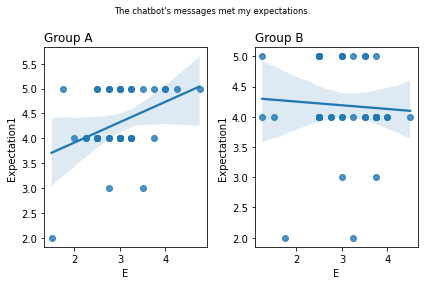







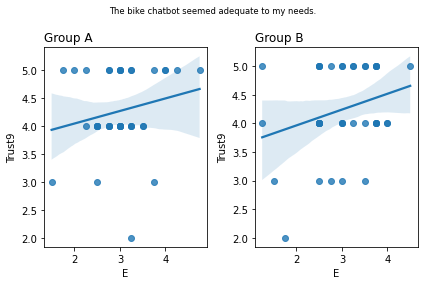

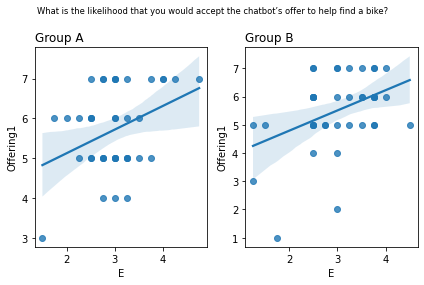

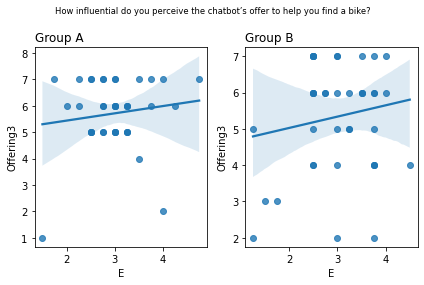
from scipy.stats import spearmanr
for q_num, q in survey_questions.iteritems():
stat, p = spearmanr(
(
summary_numeric_survey_df
.query('group == "Group A"')
.iloc[:41,:]
[q_num]
),
(
summary_numeric_survey_df
.query('group == "Group B"')
.iloc[:41,:]
[q_num]
)
)
print('stat=%.3f, p=%.3f' % (stat, p),q)
stat=0.346, p=0.027 The chatbot's messages met my expectations.
stat=0.342, p=0.029 The chatbot's messages corresponded to how I expected it to communicate with me.
stat=0.197, p=0.216 The bike chatbot seemed to care about me.
stat=0.117, p=0.467 The bike chatbot made me feel good.
stat=0.036, p=0.823 I believe the bike chatbot was honest with me.
stat=0.068, p=0.675 I believe the bike chatbot didn’t make false claims.
stat=0.139, p=0.385 I believe the bike chatbot is trustworthy.
stat=0.119, p=0.459 I trust the bike chatbot.
stat=0.292, p=0.064 The bike chatbot seemed adequate to my needs.
stat=0.008, p=0.963 The chatbot's messages were appropriate.
stat=0.029, p=0.855 What is the likelihood that you would accept the chatbot’s offer to help find a bike?
stat=0.029, p=0.856 How probable is it that you would accept the chatbot’s offer to help find a bike?
stat=0.126, p=0.434 How influential do you perceive the chatbot’s offer to help you find a bike?
SPSS Files¶
Pandas can also load SPSS files
#pip install pyreadstat
#spss_df = pd.read_spss()
#spss_df
